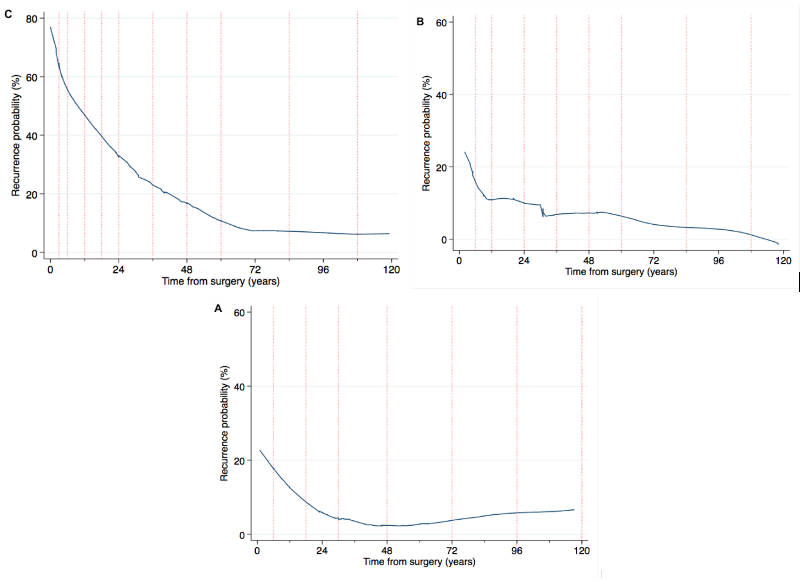Back
Poster, Podium & Video Sessions
Podium
PD15: Kidney Cancer: Epidemiology & Evaluation/Staging/Surveillance I
PD15-08: When to de-intensify oncologic surveillance scheme for non-clear cell renal cell carcinoma
Friday, May 13, 2022
4:40 PM – 4:50 PM
Location: Room 245
Alberto Martini, Daniele Cignoli, Giuseppe Rosiello, Giuseppe Fallara, Giuseppe Basile, Luigi Nocera, Federico Belladelli, Gianmarco Colandrea*, Daniela Canibus, Chiara Re, Giacomo Musso, Francesco Cei, Francesco De Cobelli, Giorgio Brembilla, Alberto Briganti, Andrea Necchi, Daniele Raggi, Roberto Bertini, Francesco Montorsi, Andrea Salonia, Alessandro Larcher, Umberto Capitanio, Milan, Italy
- GC
Podium Presenter(s)
Introduction: The 2021 EAU guidelines on renal cell carcinoma (RCC) have been implemented to provide separate recommendations on oncologic surveillance for low- intermediate- and high risk RCC and by classifying those risks differently in case of clear cell (CC) vs. non-CC. In this study we aimed to evaluate whether the surveillance scheme is accurate for patients with non-CC RCC.
Methods: We identified 461 patients with non-CC RCC from a single-institutional database. Patients were followed up in compliance with the EAU guidelines. The crude risk of recurrence was evaluated against time from surgery, as either partial or radical nephrectomy, with the Locally Weighted Scatterplot Smoothing. The risk of recurrence at the time points when imaging should be de-intensified according to the EAU guidelines was estimated.
Results: Overall, 199 (43.2%), 119 (25.8%) and 143 (31%) patients resulted in low- intermediate- and high-risk group as defined by the Guidelines, respectively. Overall, 11% of the patients relapsed during the follow-up. Figure 1 displays the risk of recurrence over time for the low- (1A) intermediate (1B) and high-risk group (1C), respectively. Vertical lines correspond to the time points when imaging should be obtained. For low-risk patients, the risk of recurrence fell below 10% after 18-month, at 30-month, time point after which imaging should be de-intensified to biannually, the risk of recurrence was 8%. For intermediate risk patients, the risk of recurrence fell below 10% after 24-month, at 60-month, time point after which imaging should be de-intensified to biannually, the risk of recurrence was approximately 7%. For patients with high risk, imaging should be de-intensified to annually from 24-month and to biannually from 60-month. The risk of recurrence at 24-month was approximately 35% at 24-month and 10% at 60-month.
Conclusions: Our findings suggest that surveillance scheme for patients with non-ccRCC can be furtherly improved. In patients with low risk, given a low recurrence probability, imaging can be de-intensified to biannually from 18 months after surgery. For individuals with intermediate risk, imaging should be de-intensified to biannually from 24-month. Conversely, for high-risk patients, imaging should be intensified to biannually till 36-month.
Source of Funding: none

Methods: We identified 461 patients with non-CC RCC from a single-institutional database. Patients were followed up in compliance with the EAU guidelines. The crude risk of recurrence was evaluated against time from surgery, as either partial or radical nephrectomy, with the Locally Weighted Scatterplot Smoothing. The risk of recurrence at the time points when imaging should be de-intensified according to the EAU guidelines was estimated.
Results: Overall, 199 (43.2%), 119 (25.8%) and 143 (31%) patients resulted in low- intermediate- and high-risk group as defined by the Guidelines, respectively. Overall, 11% of the patients relapsed during the follow-up. Figure 1 displays the risk of recurrence over time for the low- (1A) intermediate (1B) and high-risk group (1C), respectively. Vertical lines correspond to the time points when imaging should be obtained. For low-risk patients, the risk of recurrence fell below 10% after 18-month, at 30-month, time point after which imaging should be de-intensified to biannually, the risk of recurrence was 8%. For intermediate risk patients, the risk of recurrence fell below 10% after 24-month, at 60-month, time point after which imaging should be de-intensified to biannually, the risk of recurrence was approximately 7%. For patients with high risk, imaging should be de-intensified to annually from 24-month and to biannually from 60-month. The risk of recurrence at 24-month was approximately 35% at 24-month and 10% at 60-month.
Conclusions: Our findings suggest that surveillance scheme for patients with non-ccRCC can be furtherly improved. In patients with low risk, given a low recurrence probability, imaging can be de-intensified to biannually from 18 months after surgery. For individuals with intermediate risk, imaging should be de-intensified to biannually from 24-month. Conversely, for high-risk patients, imaging should be intensified to biannually till 36-month.
Source of Funding: none


.jpg)
.jpg)